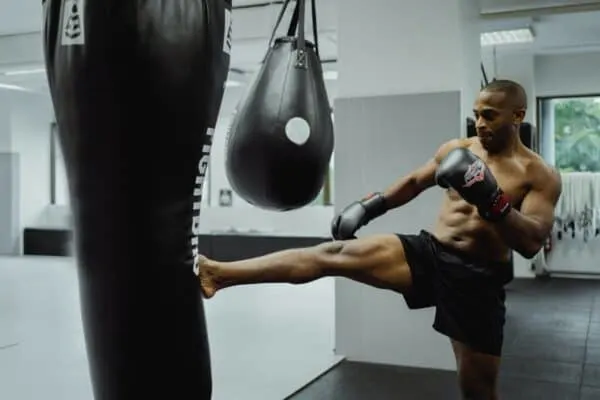
DISCLAIMER: MMACHANNEL strongly recommends that you consult with your physician before beginning any exercise program. You should be in good physical condition and be able to participate in the exercise. MMACHANNEL is not a licensed medical care provider and represents that it has no expertise in diagnosing, examining, or treating medical conditions of any kind, or in determining the effect of any specific exercise on a medical condition.
Many martial arts incorporate kicks as part of their defense and attack repertoire, but these moves can be difficult to execute with precision, power, and speed. Improving your kicking power and speed will help improve your martial art’s overall effectiveness. How do you increase your kicking power?
Increasing kicking power for martial arts involves strengthening the leg, core, glute hip, and lower back muscles. These muscles are the primary source of power in a martial arts kick. Working on speed in the kick is also an important aspect of developing a good, effective kicking technique.
Kicks in martial arts can effectively stop opponents or attackers in their tracks. The kick must be delivered with power and speed to achieve its intended goal, but it can be one of the most difficult martial arts techniques to master.
What Muscles Make Kicks Stronger?
It makes sense that you can increase your kicking strength by exercising the muscles responsible for generating the power in your kicks.
Many people mistakenly believe that the power of their kicks only comes from the major leg muscles. However, developing a strong core and hip flexor muscles can contribute significantly to increasing the power of your kicks.
The following muscles are used to generate martial arts kicks and should be trained to strengthen the muscles to improve kicking power.
- Quadriceps. These are the large muscles on the top or front of your thigh.
- Adductor muscles. These are the muscles in the inner part of your thigh, also sometimes known as your groin muscles.
- Abductor muscles. This is the group of muscles on the outer side of the thigh. When these muscles are strengthened, the overall coordination of body movements is improved.
- Hamstrings. The hamstrings are a system of muscles and tendons at the back of the thigh.
- Glutes. The Gluteus Maximus is the large muscles of your buttocks and can contribute to increased power in kicks.
- Hip flexor muscles. These groups of muscles are on the front and rear of your pelvis and connect to the upper part of your legs.
- Lower back muscles. Strong lower back muscles provide increased balance, providing a stable platform to generate power in the kick.
- Core muscles. These are your abdominal muscles. Core muscles assist with balance, and strengthening these muscles will provide extra snap to your kicks.
Martial arts kicks are as much about flexibility as they are about strength. You should not only work these muscles to increase strength but also to increase flexibility.
How Can I Increase My Kicking Strength?
Exercises that develop the muscles involved in performing a kick will strengthen the muscles and enable them to create more power and strength in the kick.
Exercises To Strengthen Leg Muscles For Kicking
Any exercise that works the legs will be helpful to increase the kicking power generated by these muscles.
Quadriceps can be exercised with leg raises or with leg extensions on a gym machine.
Hamstring muscles are the large muscle groups located at the back of the thigh that can be exercised with reverse leg curls on a gym machine. This requires lying face down on the machine with your legs out straight. Bend your knees and raise your feet until your knees are at 90 degrees. Work up to adding weights to strengthen the hamstring muscles.
Adductor muscles are more difficult to exercise and easy to strain, so they need to be worked carefully. Squeezing a medicine ball between the knees or using a gym machine to simulate this movement is the best exercise. Add weighs slowly as the strength of the adductor muscles improves.
Abductor muscles can be worked at the gym by the seated abductor machine, which you operate by starting with your knees together and opening your legs outward against the resistance of the weights.
You can start exercising your abductor muscles by sitting and leaning over your knees and holding your knees together with your hands. Try using your legs to force your knees open against the resistance of your hands and arms.
Gluteus Maximus muscles can effectively be strengthened by doing lunges. Start by using small weights and slowly increase the weights to work your glutes harder.
Cycling is a great way to exercise a large number of the muscle groups needed for kicking. Cycling works your core, hip muscles, quads and hamstring muscles, and lower back.
Core muscles and lower back can be strengthened with a range of exercises, including sit-ups, torso raises, and a variety of gym machines designed to target these areas.
One of the best ways to strengthen your kicking muscles is to practice kicking. Kicking against a heavy bag will exercise all the muscle groups used to generate the kick.
Do Squats Help You Kick Harder?
Squats are a good exercise to increase the power in your quads, hamstrings, hip flexors, and glute muscles. Squats are a good exercise to increase the strength in these muscle groups, adding power to your kicks.
You do not want to perform squats with excessive weights when training for martial arts kicks. Squats with very heavy weights will build bulk in the muscles, which can develop power, but will slow down the speed of the kick.
When exercising for improvement in martial arts kicks, you must focus on developing power as well as speed.
Who Has The Hardest Kick In The World?
There is no official record of the hardest kick in the world. But there have been several professional fighters who have shown incredible kicking strength when measured with scientific tools. One very notable case is MMA fighter, Shogun Rua.
Shogun Rua is a Brazilian MMA fighter credited with one of the most powerful recorded kick in the world. This accreditation is subjective since not every martial artist has had their kicks evaluated.
Shogun Rua was rigged with sensor equipment and performed several Muay Thai kicks against a heavy bag rigged with pressor sensors.
The Muay Thai kick recorded 2749-pounds of force, which is a significant amount of power! These readings were more than double the force of Rua’s punches recorded in the same session. His punches recorded a force of 1169-pounds.
Which Is More Powerful, Kick Or Punch?
Many people rely on their punches more than their kicks in martial arts, but a good well-timed kick can be significantly more devastating than a punch.
A kick generates more power than a punch because the size of the muscle groups involved in generating the power in the kick are much larger than those used to generate power in a punch.
Although a punch also uses core muscles and hip muscles, similar to a kick, the balance of the power is generated by the upper back, shoulders, and arms.
In contrast, the power generated for a kick comes from the thigh muscles combined with the core, hip, glute, and back muscles. The muscle groups in the legs are considerably larger than the muscles in the shoulders and back.
As a result, the power generated in a kick is typically much greater than what can be delivered by a punch.
RECOMMENDED READING: How Hard Can an Average Person Punch?
How Powerful Is A Human Kick?
While Shogun Rua’s kick is exceptionally powerful, the average person can kick with 1000 pounds of force. This power can be increased with proper training and technique to levels similar to that displayed by Shogun Rua.
A 1000-pound force kick is the equivalent of 4448 newtons. Studies have revealed that a force of 3300 newtons or 741-pounds has a 25% chance of cracking ribs.
How Do I Kick Faster?
Improving kicking speed is as important as working on the power behind the kick. Speed helps to increase momentum, which in turn contributes to power in the kick.
The main reason to increase the speed of the kick is so that your opponent or attacker will not see the kick coming and will be caught by the full force of the kick.
Mastering the correct technique is important to increasing speed. Start practicing your kicks in slow motion will improve technique, and accuracy, stretch your muscles and build strength. As you work up to faster speeds, you will notice that you can kick faster and faster.
Work on your core muscles and hip flexor muscles; these muscle groups add snap or speed to your kicks.
Add weights to your ankles when practicing your kicks. When you remove the ankle weights, your feet will feel lighter, and you will move more quickly. Bruce Lee used this strategy to improve his kicking speed and power dramatically.
Want to dive deeper into learning about kicking? Read more about How Fast Can The Average Person Kick?
Which Martial Art Has The Strongest Kick?
There is some debate as to which martial art has the strongest and most effective kicks, but the general consensus is that Muay Thai has the most powerful kicking styles.
Capoeira is a Brazilian martial art with extremely effective kicks, but the techniques must be executed flawlessly for them to be delivered with full effect.
The other martial arts after Muay Thai and Capoeira with potentially devastating kicks in order of effectiveness are Taekwondo, Wushu, and Karate.
Final Thoughts
If kicks are an important part of the curriculum of the martial art you study, it makes sense to spend some dedicated time increasing the power and speed of your kicks.
Many martial arts students neglect this part of their training and focus on the punches since the kicks are more difficult to master and execute correctly.
Working on your kicking muscles and techniques will also improve your balance and stability, which will improve other aspects of your martial arts training.
